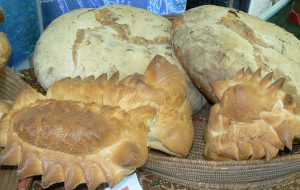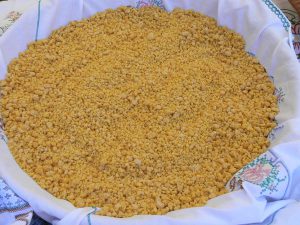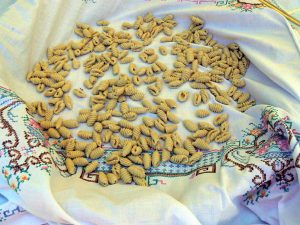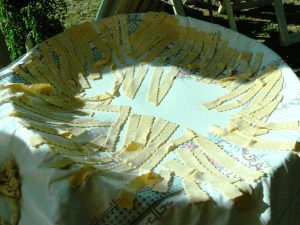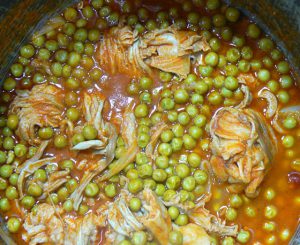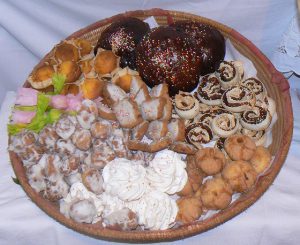Mediterranean, characterized by the insularity, by the agro-pastoral culture and prepared with poor ingredients, but original and natural, the Sardinian cookery presents a big heritage of typical dishes.
The cooperation of the elderly of our town allows us to go along again and to savour again the ancient alimentary traditions. The standard of living of the past forced to a real distinction between dishes for holidays and for weekdays, allowing in that way to increase the value of these dishes.
In the weekdays the lunch was quite poor, but at the same time nutritious. They ate pulses soup (broad beans, chickpeas, and beans), vegetable soup and Gastronomy with which they used to prepare:
- su mazzamurru: stale bread cut into slices, sometimes wet into hot water, after seasoned in layers with tomato sauce (not too thick) and pecorino;
- Su pani indorau (that means golden bread): stale bread soaked first with milk and after with egg. After it is fried until achieved the typical golden colour that gives it the name.
Because of its preservation quality, because of its possible uses, because doing it was economical and because of the big disposal of wheat, the bread was the food that always accompanied the courses of all the families, to the point that it was prepared by all the women in their houses.
On Friday or Saturday of each week, the homemakers used preparing:
- su maritzosu;
- Su civraxiu (ring-shaped);
- Sa pillonca;
- Su coccoi (white bread with crunchy pasta outside, made in different shapes, whose workmanship was considered an art- look at the picture);
- Sa tunda (it is similar to a “focaccia”; it was made with bran and had a round and flat shape. After cooked it took a coopery colour. Soft inside and toasted outside);
- Pani cun gerda (the kneading of the bread was enriched with pig’s lard);
- Pani de arrescottu (during the workmanship of the bread was added cottage cheese).
Often during the preparation of the bread, the women did the “panada” too. It is a typical course of the culinary tradition of Cagliari and surroundings and of our town too. It was a main course. Born as a simple pasta covering, with a characteristic pot-shape, it contains a stuffing based on eels, lamb or pulses as peas or broad beans. Malloreddusu, pillus and cruxionis were also prepared.
While the meal was reserved to Sunday launches, the pasta, strictly homemade, daily accompanied the table of the people. A typical Uta’s course was the “fregola” (look at the photo) with pecorino (commonly called “fregua incasada”): the fregola was prepared and after it was boiled into water and seasoned with tomato sauce and a lot of pecorino.
Malloreddusu, pillus and cruxionis were also prepared.
Sunday and holidays (Christmas, Easter, marriages or town festivals) represented the occasion to lay the tables; various seasonings for pasta, meat and sweeties enriched each course:
- In addition to the classic fregua incasada there was young cock meat;
- In wedding banquets, sa fregua groga was unfailing: mixture of bran, eggs and saffron that gives the colour from which derives its name;
- Malloreddusu with tomato sauce and cockerel meat;
- Roast pork (porceddu arrostu): it is a little pig, cooked on the fire using a spit;
- Roast lamb (angioneddu arrostu): it is a little lamb, cooked on the fire using a spit; it is prepared above all for Easter and Christmas;
- Plait with peas: it represents one of Uta’s characteristic recipes; it is made weaving the entrails of the lamb. Cooked into a saucepan with onions, peas and tomatoes (look at the picture).
- Lamb in broth;
- Stuffed chicken (pudda fatta a prenu).
The other sweeties that made special the holidays were ciambelle, amaretti and caschette (some examples in the picture).
Some of the courses and desserts here remembered, thanks to the transmission of the customs between old and new generations, are still part of the culinary tradition of Uta and of part of Sardinia.
Now they are made independently from the occasion and not at home, but it is what, in the past, made a course special.

